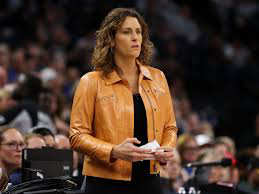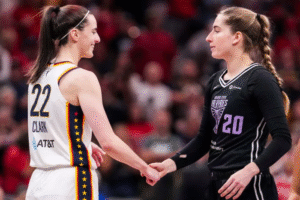
Caitlin Clark Returns, But Golden State Valkyries Dominate Indiana 80–61
On Wednesday night, the Indiana Fever saw Caitlin Clark make her comeback from a groin injury, but it was the Golden State Valkyries who stole the spotlight with a convincing 80–61 victory in the Fever’s home arena.

Clark’s Injury Layoff
Clark had sat out the previous five contests, a stretch that included the Fever’s WNBA Commissioner’s Cup championship appearance, as she recovered from a left groin injury. Her return marked a much-anticipated moment for Indiana fans, who were eager to see their star point guard back on the court.
New Lineup Comes Together
Head coach Stephanie White introduced a bold lineup, deploying a trio of guards—Clark joined by Aari McDonald and Kelsey Mitchell. This “three-guard” experiment was designed to maximize their ball-handling and shooting versatility, though it drew mixed opinions as the game unfolded. Clark’s role was especially noteworthy; she was subbed around more frequently than usual and found herself playing off the ball more often than in previous games.
Stat Line: Solid, but Not Spectacular
Clark capped off her return with 10 points, five rebounds, six assists, and four turnovers across 25 minutes of floor time. While not a poor outing by any stretch, the numbers reflect a player still easing back into peak form. The Fever, collectively, couldn’t capitalize, dropping below a .500 record on the season and slipping to 9–10.
Post-Game Accountability
After the final horn, Clark didn’t mince words. She candidly addressed her team’s shortcomings—particularly on defense—in a game that could have served as a resurgence for Indiana but instead highlighted areas in need of improvement.
> “It starts on the defense,” Clark emphasized. “We struggled to do what the coach asked of us.”
This blunt assessment echoed a performance that fell short of expectations. The Fever were flagged for significant defensive lapses that gave Golden State room to breathe.
Clutch Factors: 3-Pointers and Rebounds
Two glaring statistical discrepancies stood out:
1. Perimeter Vulnerability: The Valkyries drained 12 three-pointers, a figure notably higher than their season average of 8.9 triple here. Golden State was already the league’s most prolific perimeter shooting team, averaging a whopping 30.1 attempts from beyond the arc per game. Indiana simply couldn’t clamp down on shooters, allowing long-range shooters to feast.
2. Second-Chance Points: On the glass, Indiana was outmuscled 47–36 in rebounding. Golden State secured 11 offensive boards, giving them repeated second-chance scoring opportunities. Clark acknowledged these struggles, pointing to low energy and effort as contributing factors.
> “We played with poor energy and effort—those are things that can’t happen.”
Clark’s Recovery and Outlook
On a more encouraging note, Clark reported that her body felt solid. Despite a conservative limit on minutes, she said she felt “pretty good” and trusted that she’d regain peak conditioning and timing with additional playing time.
> “Just trying to get my legs underneath me and get my wind back, which will happen in the next few games,” she told reporters.
The Fever now face several more matchups before the WNBA All-Star break—two of them at home. These include games against the Atlanta Dream on Friday and the Dallas Wings on Sunday. These contests will be held at Gainbridge Fieldhouse, where two of Indiana’s All-Star representatives, Aliyah Boston and Kelsey Mitchell, are expected to shine for “Team Clark.” Following the homestand, the team turns its attention to two road tilts against the Connecticut Sun and the New York Liberty.
In-Depth Analysis
Let’s break down the game and implications in greater detail:
1. Lineup Experiment: Three Guards
Tactical Goal: White’s decision to start three guards was likely aimed at boosting speed, spacing, and perimeter shooting—an identity the Fever have tinkered toward throughout the season.
Execution Variances: Early in the season, this setup produced goods: quick ball movement, open threes, and transition offense. With Clark back, some expected this trio to operate at full charge, but execution fell short. Clark’s off-ball role limited her influence, while McDonald and Mitchell couldn’t consistently carry the perimeter offensive burden. The result? A defensive mismatch and an inability to maintain consistent rhythm.
2. Defensive Breakdown
Lack of Discipline: Clark noted that the team didn’t execute coach’s defensive schemes. Whether this was poor communication, lack of engagement, or tactical breakdowns, it showed up on the stat sheet.
3-Point Deficit: Allowing 12 made threes to a team thirsting for perimeter stretch was a low point. Golden State’s 3-point volume (avg. 30.1 attempts/game) is league-leading, and once given space, they punished the Fever.
3. Rebounding Battles Lost
Glass Control Errors: Indiana conceded 11 offensive boards. These aren’t just rebounds—they’re momentum. Each offensive rebound means extended possessions, tiring defense, and demoralizing resets. This stat highlighted a team that physically didn’t match up against Golden State’s athleticism and pursuit mentality.
Finished Record: A 47–36 rebounding deficit is telling. It means 11 more possessions—and potentially 20+ points—allowed for the Valkyries. It told the story of a physical mismatch amid an athletic contest.
4. Clark’s Return
Progression Path: After recovering from a five-game absence, Clark’s comeback was always staged. The 25-minute cap allowed her to test groin durability, timing, and conditioning without taking excessive strain.
Metrics: Ten points and six assists show she ran the offense, but the four turnovers indicate that she wasn’t fully locked in playmaking-wise. Still, six assists attest to her court vision; it’s a win that she didn’t suffer any setbacks in a competitive WNBA environment.
Energy Notes: She explicitly stated she felt “pretty good.” That’s crucial. Many athletes returning from injury say they feel okay physically, only to stagger later. With her feedback and the low-mileage night, prospect looks good. She’s eyeing impact over the next two weeks leading up to the All-Star break.
5. Season & Psychological Implications
Record Slide: Falling to 9–10, the Fever are treading into “below .500” territory. That’s a precarious spot where depth is tested and momentum is fragile. They’ve got to rise fast.
Confidence Drain: Losing at home after hyping up Clark’s return hurts. The narrative was strong: big boost coming back, new lineup, home environment—check, check, check. Instead, they suffered a letdown, and that demands quick crew reclamation. Clark’s leadership and ownership in addressing the loss should help galvanize a response.
Next Moves: Coincidentally, home games before the All-Star break offer a chance. The opponents—Atlanta and Dallas—are winnable are they both teams the Fever know how to beat in stretches. Staying healthy, fine-tuning rotations, and regaining consistency are on everyone’s checklist. Winning both and hitting .500 again before the break would serve as a reset.
6. Looking Ahead: All-Star Weekend
Team Clark Excitement: With All-Star Game coming at Gainbridge Fieldhouse, Clark will have two teammates in the showcase: Aliyah Boston and Kelsey Mitchell. Boston provides the interior force, while Mitchell offers a complementary perimeter shot. With Clark as anchor of “Team Clark,” the Fever will bask in local-wide attention and hopefully gain a filled arena.
Before That: But first, the Fever need to show they can win four straight, starting at home. It matters more than the friendly vibe—they need to restore competitive identity before turning the city into sellout central.
Recap and Framing
What happened: Caitlin Clark returned from her five-game absence but the team lost decisively 80–61 to Golden State.
Why it matters: Clark is the central figure of the Fever’s identity and potential playoff push. Her return should strengthen them—but this loss instead signals systemic issues: defensive discipline, rebounding toughness, and lineup execution.
Key breakdowns:
Allowed 12 threes (vs a normal ~9)
Lost the rebounding fight, 47–36, including 11 offensive boards for Golden State
Defensive execution was poor, per Clark
Energy and effort flagged as subpar
Clark’s performance: Moderately effective—10 points, six assists, four turnovers in 25 minutes. Felt good physically.
Next up: Two home games (Atlanta, Dallas) before the All-Star break—crucial tests. Then road matchups in Connecticut and New York follow.
Extended Perspective
Clutch Time
If we zoom into how the game ended—Golden State likely pulled away gradually. A big third-quarter stretch, powered by threes and tip-ins, separated the teams. Clark’s return moment didn’t translate to execution. Indiana’s offense didn’t catch fire, and defense collapsed in key segments.
Backcourt Dynamics
The three-guard frontcourt, while providing spacing, also brought wear-and-tear on smaller defenders. Golden State’s counters—quick cross-screens, drives to the rim, and switches—exposed Indiana. Down low, sizing mismatches appeared, especially as the Fever tired. It exposed why rebounding slipped—they couldn’t box out consistently.
Bench Impact
Indiana’s rotation beyond the starting nine—or sometimes eight—weren’t able to tilt momentum. Fringe players didn’t spark second-unit energy, and Golden State’s bench filled that void. Fresh players hit threes, crash boards, close out shots, and in total… the bench gap widened.
Mental State
Home crowd can be a boost—Force multiplier. But a slow start and draining lead erases that edge. Clark’s candid quotes post-game suggest they carry that frustration—but also clarity. Psychology matters. If they rebound mentally tonight, good; if they spiral, it’ll get longer.
Seasonal Standings Context
At 9–10, mid-pack in the WNBA Eastern standings, the Fever are on the bubble. They’ve leaned on youth—Boston, Clark, newcomer Sophie Cunningham, etc.—but inexperience is apparent. The compression near .500 means every game now is borderline playoff or washout. They need to win at least one more ahead of All-Star to stabilize.
External Observations
Analyst talking heads will likely highlight:
Clark’s recovery trajectory (good to see growth).
The defense-rebounding emphasis (Fever need a whale on the glass or better team discipline).
Rotational depth questions (can they maintain intensity end-to-end?).
Coaching adjustments (whether White sticks with three-guard, rolls back, or does some hybrid).
Looking Ahead: The Next Four Games
Friday vs Atlanta Dream (Home)
Atlanta is inconsistent—capable of jump shots but often scratching for wins. Fever should be favorites. Win here is must.
Sunday vs Dallas Wings (Home)
Dallas is mobile and aggressive; they crash boards and swing tempo. Close contest. Fever need energy and home-court advantage to hold.
Next week—On the road:
@ Connecticut Sun: Tough venue. Sun is a playoff team—they’ll expose defensive mistakes. Fever need compact spacing and toughness.
@ New York Liberty: Post-break matchup, national stage. Liberty’s length and skill will require Indiana to stay locked in.
Look at it as mini “pre-All-Star play-in”. Getting to break with 2–2 or better and regaining confidence would mean a lot.
Final Summary
Caitlin Clark made her return to the court—getting through 25 minutes without setback, delivering solid stats. But the Indiana Fever suffered an 80–61 home defeat to the Golden State Valkyries, marked by defensive breakdowns, rebounding struggles, and a failure to pull ahead. Clark called out the team honestly for a lack of effort, and the numbers (12 threes allowed and 11 extra offensive boards for Golden State) backed her up. With the Fever now 9–10, they face a pivotal four-game stretch leading up to the All-Star break—two at home (Atlanta, Dallas) and two road tests (Connecticut, New York). Their response in those matchups will say a lot about whether they’re trending upward—or sliding into a lower-tier battle. Clark’s return offers reason for optimism, but results and energy must follow.
Leave a Reply